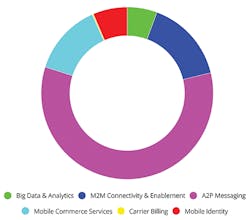Lookin’ for a Cool $120B by 2024?
Network Operators’ Value-Added Service Opportunity —
New data from Juniper Research has shown that revenue opportunities for mobile operators, outside of voice, messaging and mobile data termination, will reach $120 billion by 2024; up from $67 billion this year.
Total Revenue Opportunity for Operators, Split by Value-added-Services — $120 Billion by 2024The research predicted that average data traffic generated per user will rise from 49GB in 2019 to over 157GB by 2024. In response, the research urged operators to optimize LTE networks for data services, whilst preparing for future 5G networks.
The research also predicted that growth of future cellular traffic would be driven by increasing usage of video streaming services, such as Netflix and Hulu. It predicted that 56% of total cellular data generated by mobile handsets would be attributable to video streaming services, rising from 40% in 2019.
InvisiLight® Solution for Deploying Fiber
April 2, 2022Go to Market Faster. Speed up Network Deployment
April 2, 2022Episode 10: Fiber Optic Closure Specs Explained…
April 1, 2022Food for Thought from Our 2022 ICT Visionaries
April 1, 2022Therefore, network operators must find a series of growing revenue opportunities to help combat declining revenues from voice and messaging termination. Juniper Research predicts that these 3 sectors will be the fastest growing sectors for operators:
1. Mobile Identity Services / Digital Identity: Juniper Research considers a digital identity to be a digital representation of an entity which grants rights, access or privilege on the basis of that representation. Mobile identity services are the practical solutions linked to digital identity such as apps replacing mobile authentication or digital Know Your Customer processes, among others.
2. Direct carrier billing (DCB) is a digital payment method which allows users to make purchases by charging payments to their mobile phone bill. DCB is available to all smartphones and featurephones.
3. Cellular IoT Connectivity: Juniper Research defines cellular IoT connectivity, or M2M, as the connections, interfaces, and infrastructure, allowing data to be transferred between machines and between machines and individuals. M2M includes the management systems, interfaces, and portals, needed to extract value from the machine data.
The Top 5 Most Innovative Network Operators
Juniper Research assessed 25 leading operators in its "Operator Innovation Index"; scoring their level of agility and innovation, the breadth and quality of their solutions, and their anticipated future prospects in the field. It ranked the 5 leading operators as follows:
1. Vodafone
2. Verizon
3. AT&T
4. Telefónica
5. Telenor
Vodafone was ranked as the most innovative network operator. It scored highly for the level of network virtualization implemented in its network, its involvement in the IoT sector, and its high level of investment in trials of 5G networks.
Innovation must continue to focus primarily on reducing the capital expenditure on networks through virtualization of core networks. Operators should also continue to explore new revenue streams that leverage the mobile networks they have in place.
Like this Article?
Subscribe to ISE magazine and start receiving your FREE monthly copy today!
For more information about the Juniper Research Report Summary Mobile Operator Business Models: Challenges, Opportunities & Strategies 2019-2024, please visit https://www.juniperresearch.com/researchstore/telco-service-providers/mobile-operator-business-models





